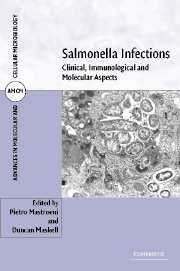Book contents
- Frontmatter
- Contents
- List of contributors
- Preface
- 1 Epidemiological and clinical aspects of human typhoid fever
- 2 Antibiotic resistance in Salmonella infections
- 3 Host-specificity of Salmonella infections in animal species
- 4 Public health aspects of Salmonella enterica in food production
- 5 The Salmonella genome: a global view
- 6 Pathogenicity islands and virulence of Salmonella enterica
- 7 In vivo identification, expression and function of Salmonella virulence genes
- 8 Mechanisms of immunity to Salmonella infections
- 9 Interactions of S. enterica with phagocytic cells
- 10 Interactions between Salmonella and dendritic cells: what happens along the way?
- 11 Immunity to Salmonella in domestic (food animal) species
- 12 Newer vaccines against typhoid fever and gastrointestinal salmonelloses
- 13 S. enterica-based antigen delivery systems
- Index
- Plate section
- References
9 - Interactions of S. enterica with phagocytic cells
Published online by Cambridge University Press: 04 December 2009
- Frontmatter
- Contents
- List of contributors
- Preface
- 1 Epidemiological and clinical aspects of human typhoid fever
- 2 Antibiotic resistance in Salmonella infections
- 3 Host-specificity of Salmonella infections in animal species
- 4 Public health aspects of Salmonella enterica in food production
- 5 The Salmonella genome: a global view
- 6 Pathogenicity islands and virulence of Salmonella enterica
- 7 In vivo identification, expression and function of Salmonella virulence genes
- 8 Mechanisms of immunity to Salmonella infections
- 9 Interactions of S. enterica with phagocytic cells
- 10 Interactions between Salmonella and dendritic cells: what happens along the way?
- 11 Immunity to Salmonella in domestic (food animal) species
- 12 Newer vaccines against typhoid fever and gastrointestinal salmonelloses
- 13 S. enterica-based antigen delivery systems
- Index
- Plate section
- References
Summary
INTRODUCTION
Mononuclear phagocytes associate with S. enterica early in the disease process before acute inflammatory abscesses are formed, as well as during later stages of the acquired immune response in which macrophages form part of well-organized granulomas (Mastroeni et al., 1995; Richter- Dahlfors et al., 1997). The ability to survive within macrophages is a key event in the pathogenesis of Salmonella enterica (Fields et al., 1986). A growing body of information indicates that macrophages can serve as sites for S. enterica replication, even though they can be activated to exert potent anti- S. enterica activity. The great majority of the intimate interactions between S. enterica and macrophages take place inside a specialized endocytic vacuole named the phagosome. This chapter discusses the dynamic S. enterica phagosome as it pertains to the pathogenesis of this intracellular Gram-negative bacterium.
Immunological and genetic manipulations in animal models of infection, as well as the observation of naturally occurring genetic traits, have revealed that genetic loci encoding Nramp1, TLR4, NADPH oxidase and IFNγ play key roles in resistance to S. enterica infection. These host defenses are expressed directly by macrophages or, as in the case of IFNγ, up-regulate the anti-S. enterica activity of mononuclear phagocytes. In the following sections, we will discuss both the mechanisms by which these host defenses contribute to the anti-S. enterica activity of macrophages, and the virulence factors used by S. enterica to avoid these components of the antimicrobial arsenal of professional phagocytes.
- Type
- Chapter
- Information
- Salmonella InfectionsClinical, Immunological and Molecular Aspects, pp. 255 - 278Publisher: Cambridge University PressPrint publication year: 2006
References
- 2
- Cited by



